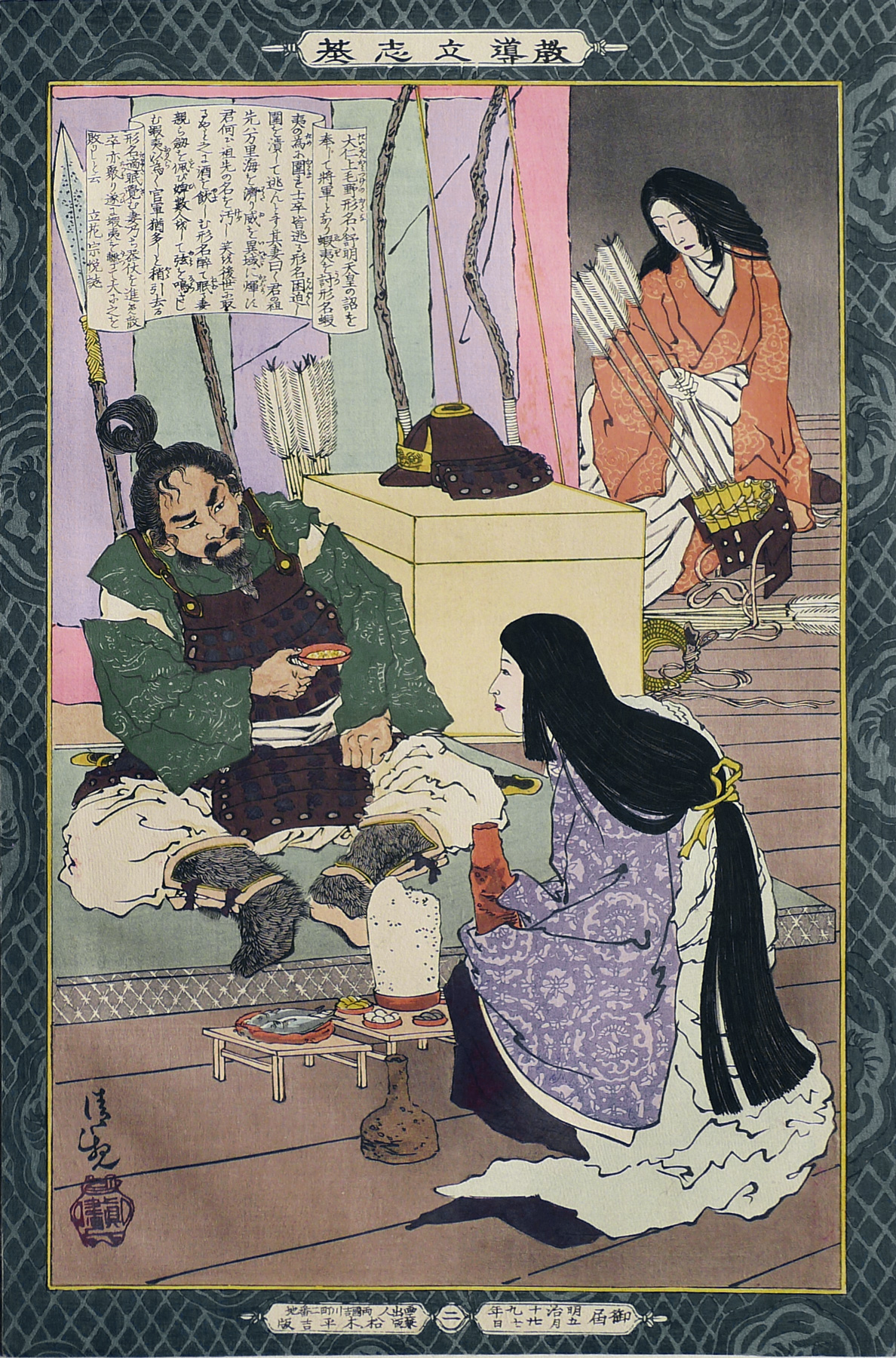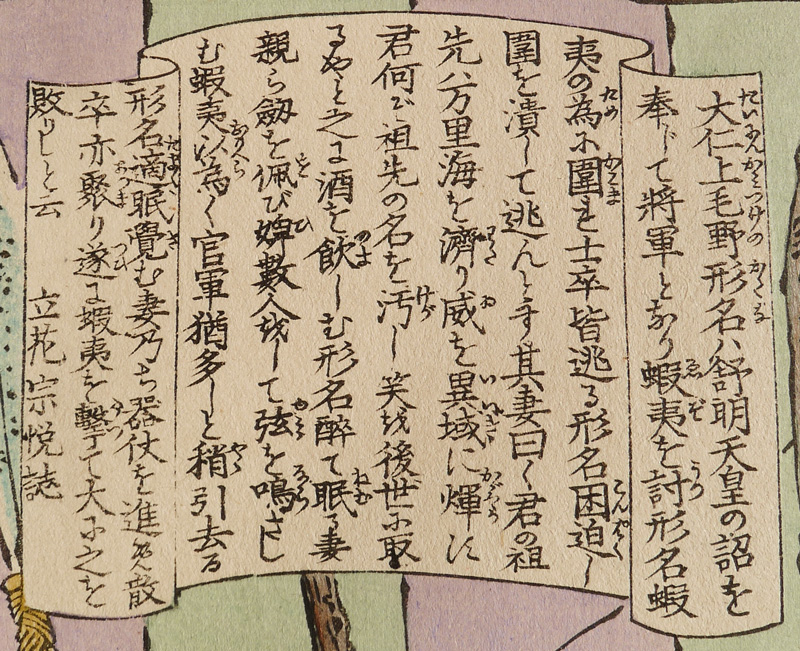About This Print
Print number 二 (2)1 in the series Instructive Models of Lofty Ambition picturing the shogun Kamitsukeno Katana eating while his wife serves him wine and lectures him to not disgrace his name and to defeat the rebels. One of the ladies of the court sits in the background, her hand grasping an arrow. (See additional details on the story below.)Kiyochika contributed 20 prints to this series. As Smith states: "Thestyle of Kiyochika’s offerings to Instructive Models of LoftyAmbition was decorous and even stiff, as befitted the didacticemphasis of the whole [series.]"2
1 Numbering of the prints was haphazard during the production of the series. Print numbers were sometimes inadvertently omitted; some prints in the series were never assigned numbers and a few of the same numbers appear on different prints.
2 Kiyochika Artist of Meiji Japan, Henry D. Smith II, Santa Barbara Museum of Art, 1988, p. 74.
The Story of Daijin Kamitsukeno Katana and His Wife
Source: The Nihon Shoki wiki http://nihonshoki.wikidot.com/scroll-23-jomeiAs told in the The Nihon Shoki 日本書紀, Japan's second oldest chronicle, completed in 720:
[In 637] there was a solar eclipse. That year, the Emishi1 revolted and did not attend the Court. Dainin Kamitsukeno Katana was made shogun [through an imperial edict issued by Emperor Jomei (reigning 629-641)] and ordered to attack them. However, he was defeated by the Emishi and fled to his castle where he was surrounded by the rebels. His soldiers all deserted, the castle was empty and the shogun did not know what to do.1 The Emishi or Ebisu (蝦夷) constituted a group of people who lived in northeastern Honshū in the Tōhoku region. They are sometimes linked to the Ainu.
At that time it was dusk, and he wanted to jump the wall and flee. Then Kamitsukeno Katana’s wife sighed, saying, “How tragic, that we will be killed by the Emishi.” Then she said to her husband, “Your ancestors crossed the blue sea, and treading 10,000 ri2, pacified the governments of the countries on the water, and their powerful warrior spirit went on to future generations. Now you will stain the name of your ancestors, and you will certainly be laughed at by future generations.” Then she poured wine, and made him drink it. She then, on her own, took her husband’s sword, and strung ten bows, and ordered ten or so other women to pluck their strings. Then her husband woke up and took his weapons and advanced. The Emishi thought the army was large, and so retreated. Then the Katana's scattered soldiers again collected, and took their formations. The Emishi suffered great loss, and were completely captured.
2 old Japanese unit of distance, approx. 3.927km or 2.44 miles
Transcription of Scroll
Source: with thanks to Yajifun http://yajifun.tumblr.com/click on image to enlarge
教導立志基 ニ 上毛野形名 小林清親 1886年5月27日
Transcription: [scroll text by 立花宗悦]
“大仁上毛野形名ハ舒明天皇の詔を奉じて将軍となり蝦夷を討形名蝦夷の為に圍れ士卒皆逃る 形名困迫し圍を潰して逃んとす 其妻曰く 君の祖先ハ万里海を濟(わた)り威を異域に煇(かゞやか)す 君何ぞ祖先の名を汚し笑を後世に取るや と之に酒を飲しむ 形名醉て眠る 妻親ら劔を佩び婢數人をして弦を鳴さしむ 蝦夷以為(おもへら)く官軍猶多しと稍引去る 形名適眠覺(さ)む 妻乃ち器仗を進め散 卒亦聚(あつま)り遂に蝦夷を撃て大に之を敗りしと云 立花宗悦 誌”
About The Series "Kyōdō risshi no motoi"
Notes:1. This series is variously translated as "Instructive Models of Lofty Ambition," "Foundations of Learning and Achievement," "Foundation of Instruction and Perseverance," "Self-Made Men Worthy of Emulation," "Paragons of Instruction and Success," "Moral of Success," "Examples of Self-Made Leaders," and "Instruction in the Fundamentals of Success." The title in Japanese is sometimes seen as "Kyōdō risshiki or "Kyōdō risshi no moto," in addition to the most commonly seen transliteration of "Kyōdō risshi no motoi".
2. For a complete listing of all the prints in the series and additional information please see the article on this site titled Instructive Models of Lofty Ambition.
This series ran between October 1885 and November 1890 and featured a long list of heroes and heroines, from antiquity to contemporary times, who were regarded as standards of moral leadership and self-realization.
Source: Kiyochika Artist of Meiji Japan, Henry D. Smith II, Santa Barbara Museum of Art, 1988, p. 74-75; original research and as footnoted.
This series of 58 prints,1 plus a table of contents sheet (目録), were originally published between October 1885 and November 1890 by the Tokyo publisher Matsuki Heikichi 松木平吉.2 The table of contents sheet issued by the publisher states that "fifty prints make up the complete set (五十番揃)". Three prints not in the initial release were added over the five year publication period, as were five redesigns of original prints, eventually increasing the total print count to 58. The seven artists contributing prints were Kobayashi Kiyochika (1847-1915) [20 prints], Mizuno Toshikata (1866-1908) [16 prints], Inoue Tankei (Yasuji) (1864-1889) [13 prints], Taiso (Tsukioka) Yoshitoshi (1839-1892) [5 prints], Yōshū Chikanobu (1838-1912) [2 prints], Toyohara Kunichika (1835–1900) [1 print], and Hachisuka (Utagawa) Kuniaki II (1835-1888) [1 print]. All the artists, with the exception of Yōshū Chikanobu, are listed in the top scroll of the table of contents sheet. Various colors (including blue, blue/green, and tan/brown) were used for the decorative border, and in 1902 the series was re-issued by Matsuki without borders.
This series of 58 prints,1 plus a table of contents sheet (目録), were originally published between October 1885 and November 1890 by the Tokyo publisher Matsuki Heikichi 松木平吉.2 The table of contents sheet issued by the publisher states that "fifty prints make up the complete set (五十番揃)". Three prints not in the initial release were added over the five year publication period, as were five redesigns of original prints, eventually increasing the total print count to 58. The seven artists contributing prints were Kobayashi Kiyochika (1847-1915) [20 prints], Mizuno Toshikata (1866-1908) [16 prints], Inoue Tankei (Yasuji) (1864-1889) [13 prints], Taiso (Tsukioka) Yoshitoshi (1839-1892) [5 prints], Yōshū Chikanobu (1838-1912) [2 prints], Toyohara Kunichika (1835–1900) [1 print], and Hachisuka (Utagawa) Kuniaki II (1835-1888) [1 print]. All the artists, with the exception of Yōshū Chikanobu, are listed in the top scroll of the table of contents sheet. Various colors (including blue, blue/green, and tan/brown) were used for the decorative border, and in 1902 the series was re-issued by Matsuki without borders.
Brief texts contained within a scroll-like cartouche appearing on each print provide historical details. The scroll composer's name is given at the end of the scroll text. The “lofty ambition” of the title is a Confucian concept, originally from Mencius, meaning “righteous determination that would inspire others.” The market for the series probably included former samurai, ambitious youth, and conservative intellectuals.
"[W]hen it was completed in 1890 the publisher was singled out for special recognition by the government for having sponsored such noble subject matter."3
1 The Tokyo Metropolitan Library online collection shows 50 prints and a Table of Contents sheet. The Table of Contents lists the titles of 50 prints. Smith in Kiyochika Artist of Meiji Japan identified 52 prints. I have identified 58 prints from this series including five prints (Ikina, Michizane Sugiwara, Kesa Gozen, Soga Brothers and Hokiichi Hanawa) that were re-designed and re-printed, likely due to damaged or lost blocks.
2 Robert Schaap notes in Appendix II, p. 166 of Yoshitoshi, Masterpieces from the Ed Freis Collection, Chris Uhlenbeck and Amy Reigle Newland, Hotei Publishing, 2011 that the series originally appeared as newspaper supplements.
3 The World of the Meiji Print: Impressions of a New Civilization, Julia Meech-Pekarik, Weatherhill, 1986, p. 122.
Print Details
| IHL Catalog | #949 |
| Title or Description | Dainin Kamitsukeno Katana 大仁上毛野形名 |
| Series | “Instructive Models of Lofty Ambition” (Kyōdō risshiki 教導立志基) [note: seriestitle also seen as 'Kyodo Risshi no Moto', ‘Kyodo risshi no motoi’,‘Kyōdō risshi ki’ and variously translated as “Moral of success” or“Foundations of learning and achievement” or “Self-made Men Worthy ofEmulation” or “Examples of Self-made Leaders” or "Paragons of instruction and success"] |
| Artist | Kiyochika Kobayashi (1847-1915) |
| Signature |  |
| Seal | shin ga 真画 (as shown above) |
| Publication Date | May 27, 1886 original publication 明治 十九年 五月 廿七日 |
| Publisher | Matsuki Heikichi (松木平吉) proprietor of Daikokuya Heikichi [Marks: seal not shown; pub. ref. 029] click on image to enlarge (from right to left) publishing and printing date: 御届 明治十九年 五月 廿七日 [notification delivered, Meiji 19 5th month 27th day] assigned number within series: 二 [2] publisher information: 画工兼 出版人 両国吉川町二番地 松木平吉 版 [artist and publisher Ryōgoku Yoshikawachō 2-banchi Matsuki Heikichi han] |
| Impression | excellent |
| Colors | excellent |
| Condition | excellent - backed; margin trimmed to brocade border; minor waviness from backing |
| Genre | ukiyo-e; rishki-e; kyōiku nishiki-e |
| Miscellaneous | print number 2 (二); position 2 in the Table of Contents for the series |
| Format | vertical oban |
| H x W Paper | 14 1/8 x 9 1/4 in. (35.6 x 23.5 cm) |
| H x W Image | same as paper size |
| Literature | |
| Collections This Print | Tokyo Metropolitan Library 280-K014 (1886 edition with light brown brocade border, as pictured above); Smithsonian Institution Freer Sackler S1995.116.2 (border trimmed); Edo Tokyo Museum 96200363 |



